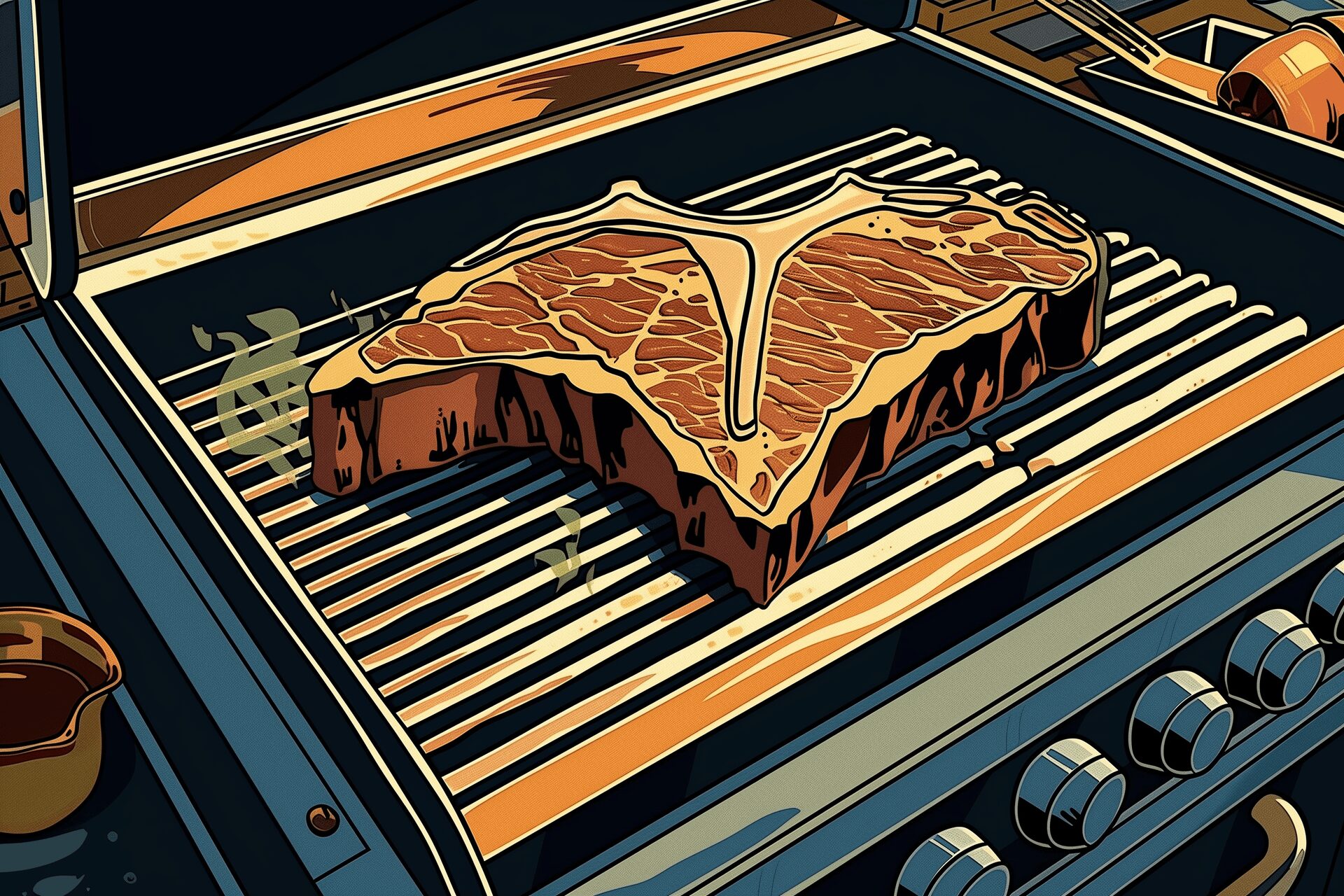From Rare to Well-Done: Mastering the Best Way to Grill a Steak
Aug 06, 2024

As an Amazon Associate, Modded gets commissions for purchases made through links in this post.
What’s the best way to grill a steak? It depends on who you ask. Everyone’s got a different opinion about how to go about it and how cooked it should be. Admittedly, grilling steak can be intimidating, especially if it’s your first time, but it’s actually a straightforward process once you nail down the basics.
Explore the nuances of grilling a steak to perfection, from selecting the proper cut to monitoring doneness levels, and unlock a world of flavor and tenderness in every bite. Here’s the best way to grill a steak.
Ingredient Notes
First things first, you’ll need to sort out the ingredients for your steak dish. The most important things to gather are:
- Steaks: Grill masters recommend choosing steaks that are 1.5 – 2 inches thick, though slightly thicker is better than slightly thinner, as thick cuts help retain juiciness and ensure even cooking.
- Olive oil: You need a high-heat oil to create a beautiful sear on the steaks. Feel free to substitute olive oil with vegetable or canola oil as you see fit.
- Seasonings: Generally, you want to keep things simple and let the flavor of the meat itself shine through. Some salt, black and white pepper, and any other seasoning of your choice should suffice.
- Butter: A stick or two of butter helps add juiciness to the steak’s crust. It also prevents the meat from drying out during cooking.
Choosing the Best Cuts for Grilling

You will usually find three grades of beef steak in a typical supermarket: Select, Choice and Prime. This grading is assigned based on the intramuscular fat marbling of the meat and helps identify its juiciness and tenderness when cooked.
Select is the leanest of the three, meaning it will most likely dry out during grilling. You’re better off going for Choice or Prime grade steaks, as they have adequate marbling to undergo the fiery process and still come out juicy.
For the cuts, you’ll find several options:
- Filet Mignon: Filet is prized for its melt-in-your-mouth texture and delicate flavor. Thanks to its lower fat content, it’s also less likely to cause flare-ups.
- Sirloin: The lean nature of sirloin steak makes it an excellent choice for health-conscious consumers. It also boasts a distinctive flavor profile that differentiates it from other lean cuts.
- Ribeye: These ultra-flavorful steaks are the ideal choice for grilling. The ribeye’s higher fat content helps keep the meat juicy even when cooked over very high heat.
- T-Bone and Porterhouse: These cuts offer a combination of textures and flavors. Keep an eye on the bone though, so it doesn’t cause uneven cooking.
- New York Strip: This cut is not the most tender steak, but people love it for its great bite and flavor. The lower fat content means there are fewer flare-ups during grilling.
- Flank and Skirt Steak: The thinnest and often leanest of the bunch — these cuts are perfect for quick grilling.
Preparing Your Steak
Nailing the prep stage is essential to achieving a perfect cook. For starters, you want the steak to reach room temperature for at least 30 minutes before putting it on the grill. Next, pat the meat dry with paper towels. This will remove all moisture and allow for a nice sear. Continue patting it until you see no more moisture coming off.
Seasoning the steak comes next. The type of cut will likely determine how you approach this step. Generally, you want to coat the meat in a thick blanket of kosher salt, pepper and garlic powder. Feel free to add other seasonings, but be careful not to overdo it, as too much can overpower the flavor.
If you’re using leaner meats, it might be best to marinate the steak instead. The lower fat content of these cuts means they require an extra helping of wet seasoning to bring out the flavor profile. To make the marinade, start with olive oil, then whisk in something fresh like herbs and citrus and sweet like honey or maple syrup.
Grilling the Steak

Fire up your grill and make sure it’s nice and hot. The best way to grill a steak is to use direct heat — over the flame. This is what gives the meat that beautiful dark char. Place the seasoned steaks on the grill and let the fire do its work.
The type of cut generally determines how long you let the meat cook before flipping it. For a one-inch steak, grill each side for 3–4 minutes, depending on the desired doneness. Thicker steaks can tarry on the grill a bit longer, especially if you don’t plan on using indirect heat to finish off the cooking.
Once a side is golden brown and slightly charred, flip it and let the other side cook. Avoid flipping the steak too frequently — aim for just once to ensure even cooking. Use tongs instead of a fork to prevent piercing and losing juices.
When grilling steaks, temperature is more important than time. Grab your digital cooking meat thermometer and insert it into the thickest part of the meat, making sure to avoid the bone and fatty areas.

Monitoring Doneness
Keep in mind that while you can always return a steak to the grill if it’s not cooked enough to your liking, you can’t undo it if it’s overcooked. That’s why it’s important to monitor the level of doneness carefully. Follow this guideline:
- Rare: 125°F to 130°F
- Medium-rare: 130°F to 135°F
- Medium: 135°F to 145°F
- Medium-well: 145°F to 150°F
- Well done: 155°F to 160°F
After you remove the steak from the grill, its internal temperature will continue to rise. Experts recommend taking the meat off when it reaches about 5˚ lower than your desired temperature to get that perfect cook inside and out.
The Thumb Test
If you don’t have a meat thermometer, you’ll have to measure the level of doneness by hand. Don’t worry, it’s a straightforward process. Lightly touch your thumb to your index finger and feel the fleshy area.
Rare steak should feel soft with little to no resistance, almost like you’re touching raw meat. Medium-Rare should feel soft yet firmer with a bit of resistance. Medium-Well and Well-Done are generally firm with very little give when pressed.
Resting and Serving

This is the final step and potentially the most critical. After being on the grill for several minutes, your steaks need to rest so they won’t lose as much juice when cutting into them.
Culinary expert Martha Stewart recommends letting your steaks rest for half the time you used to cook them. So, if you cook the meat for 16 minutes, let it rest for 8. When resting your steaks, make a little aluminum foil tent around them so they don’t cool down too quickly.
Should You Grill Steak on High or Medium Heat?
You want to start with high heat to give the steak that flavorful char. Make sure your grill temperature is between 450°F and 500°F before placing the meat.
How to Keep Steak Juicy on the Grill
The best way to keep your steak juicy during grilling is to use tender, well-marbled meat. Ribeye, T-Bone, Porterhouse and Filet Mignon are usually the ideal choices for achieving the perfect balance between juiciness and flavor.
Master the Best Way to Grill a Steak
The secret behind the best way to grill a steak is that there really is no secret at all. As long as you pay attention to these guidelines and best practices, you’re well on your way to becoming a grill boss in no time.





